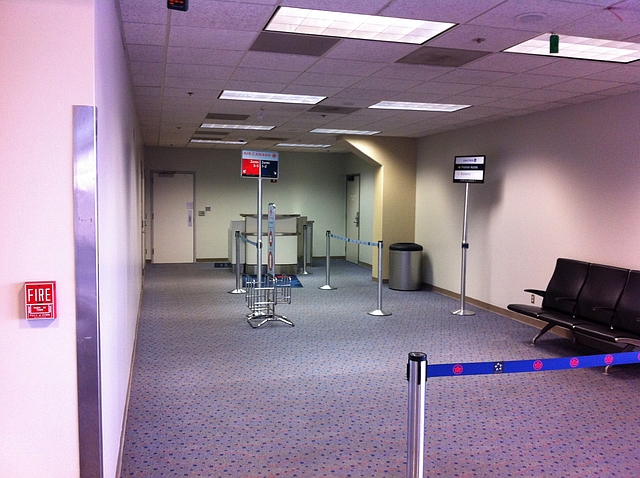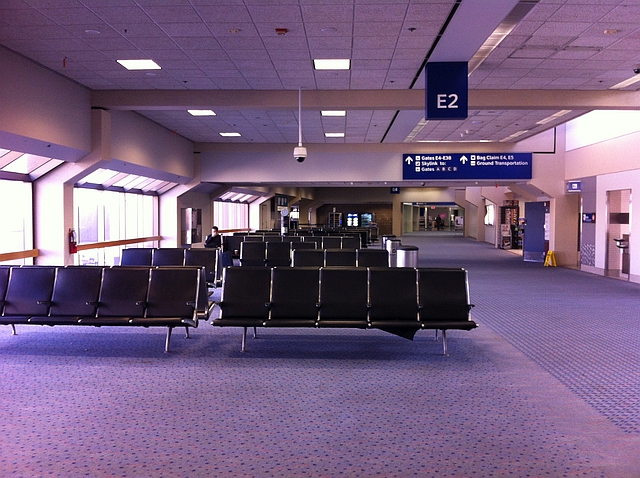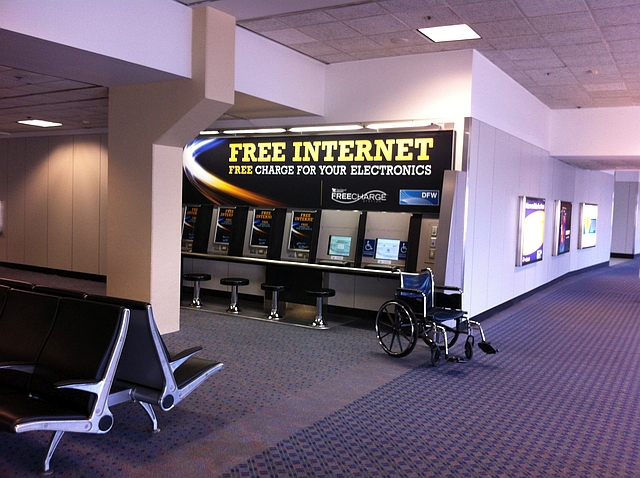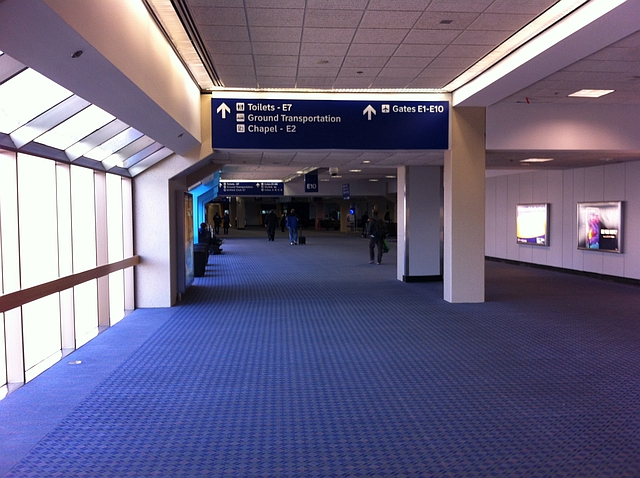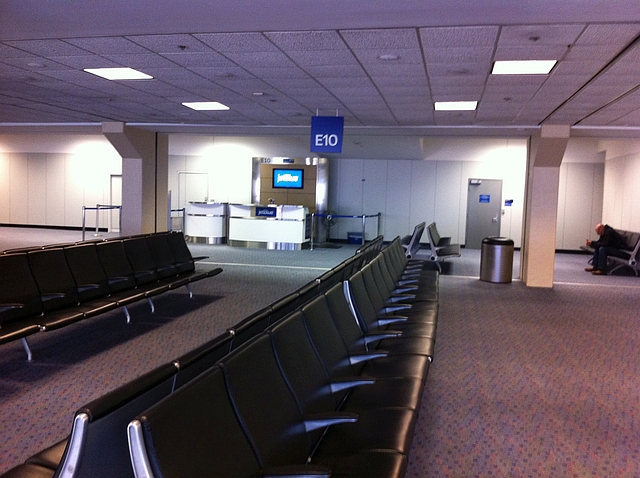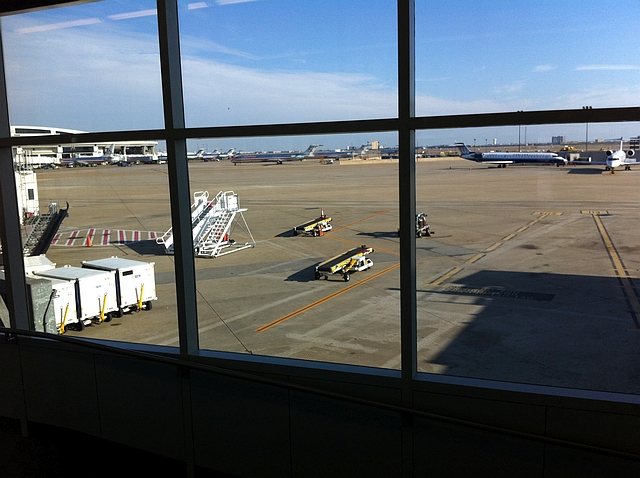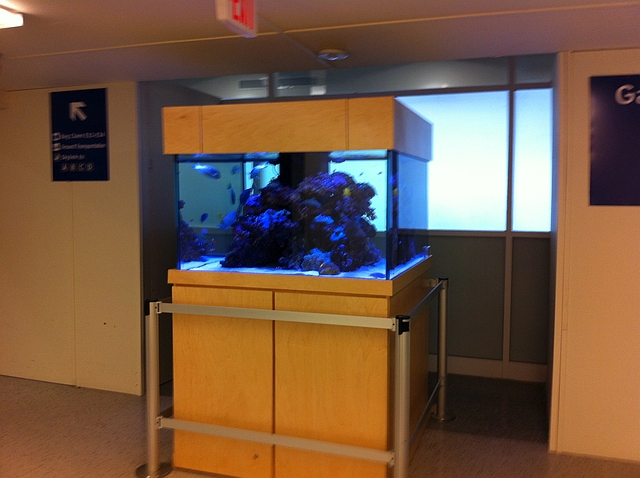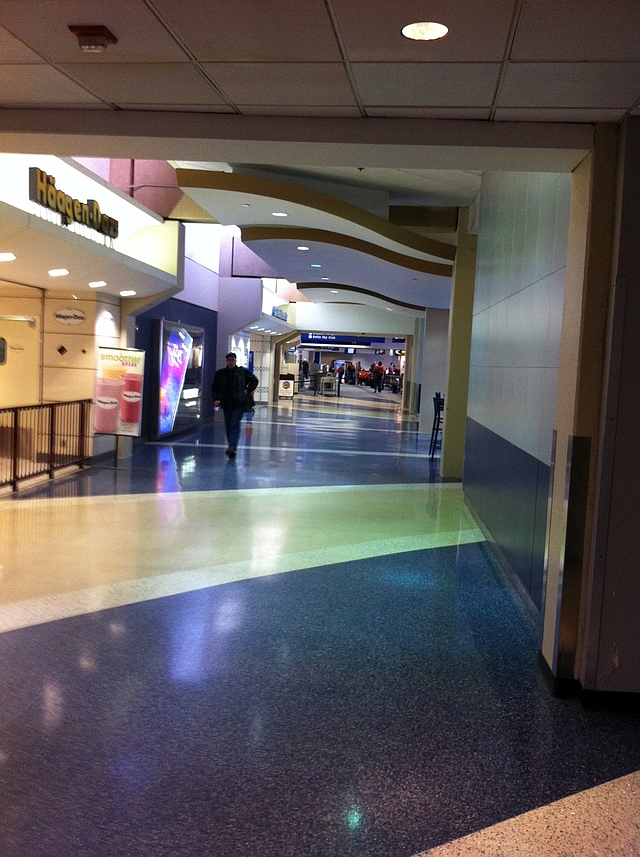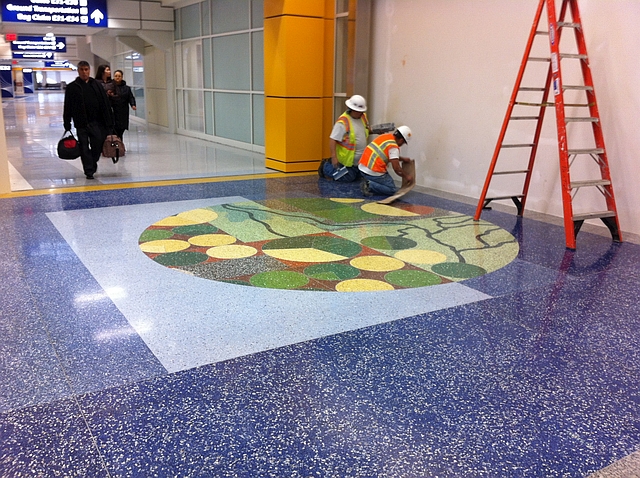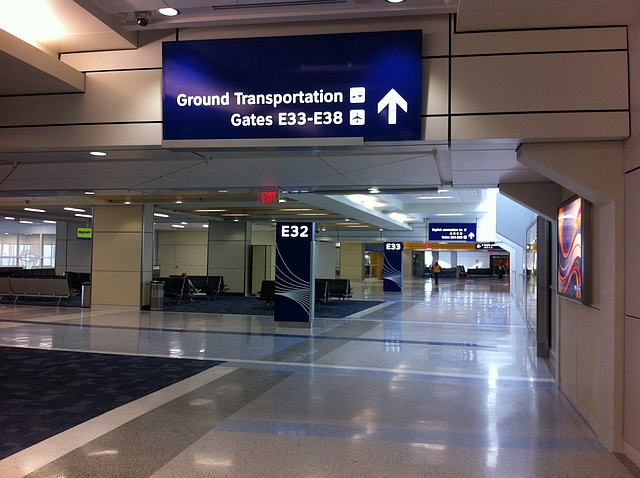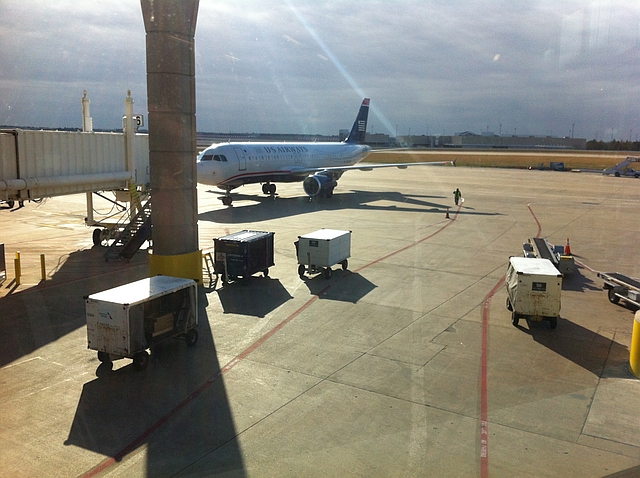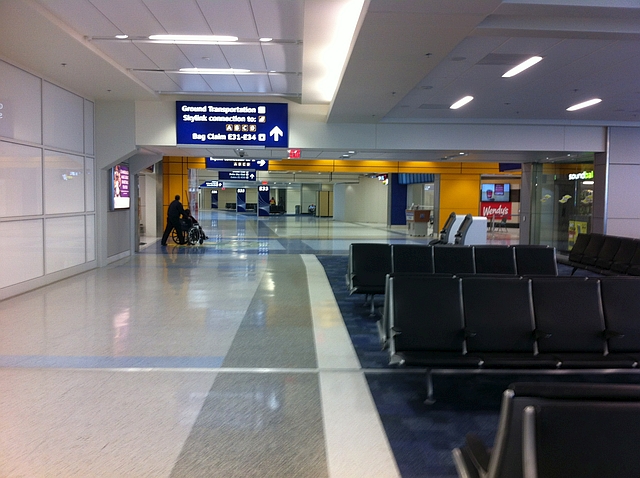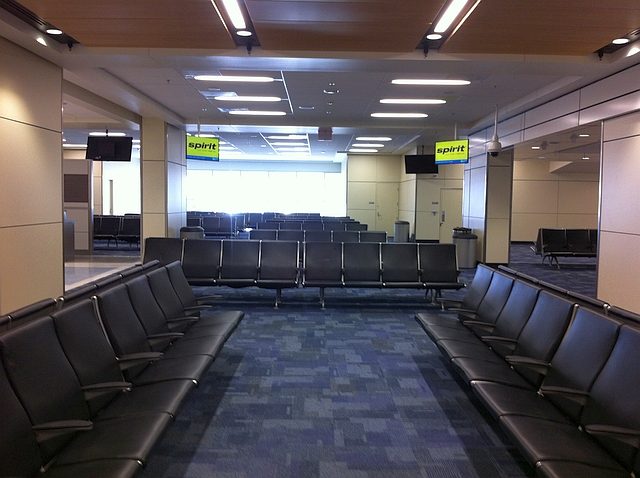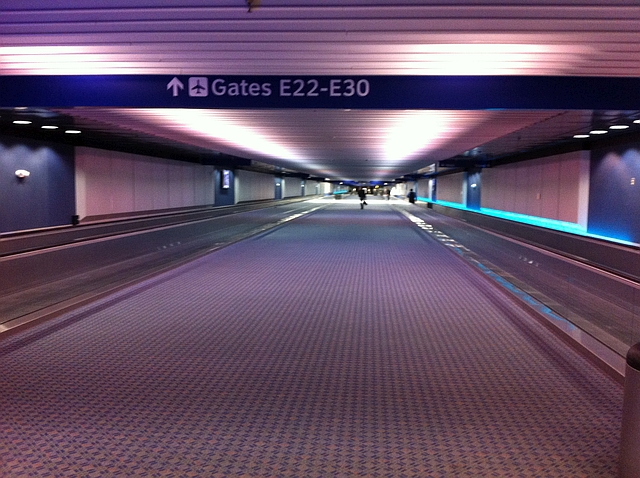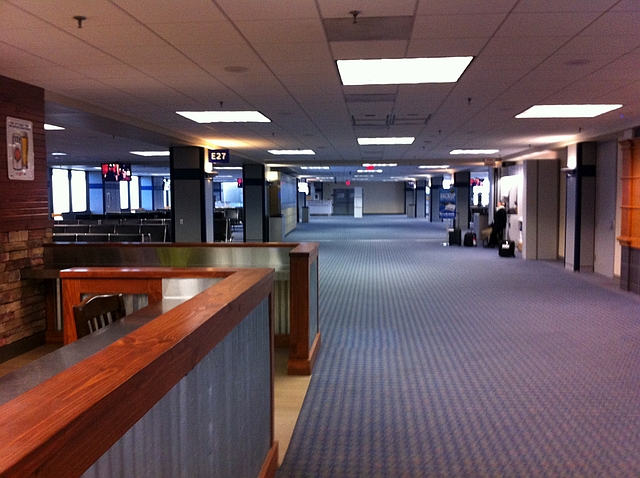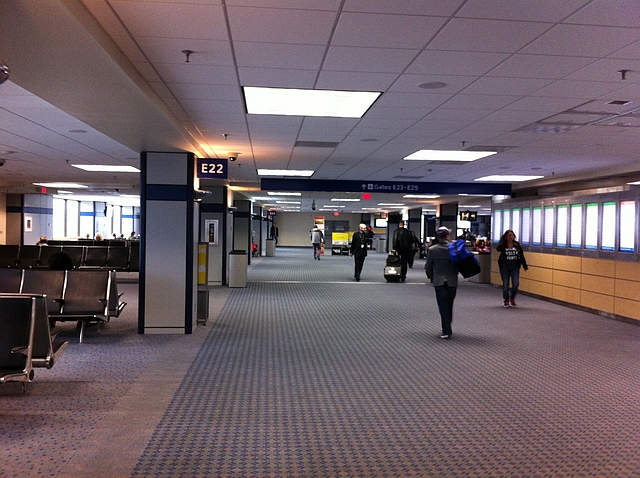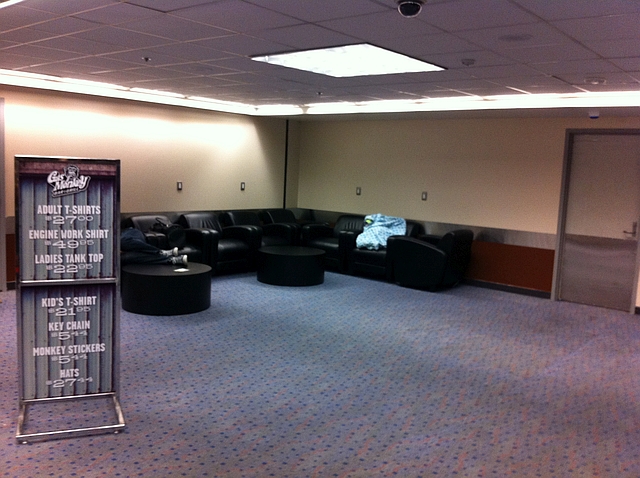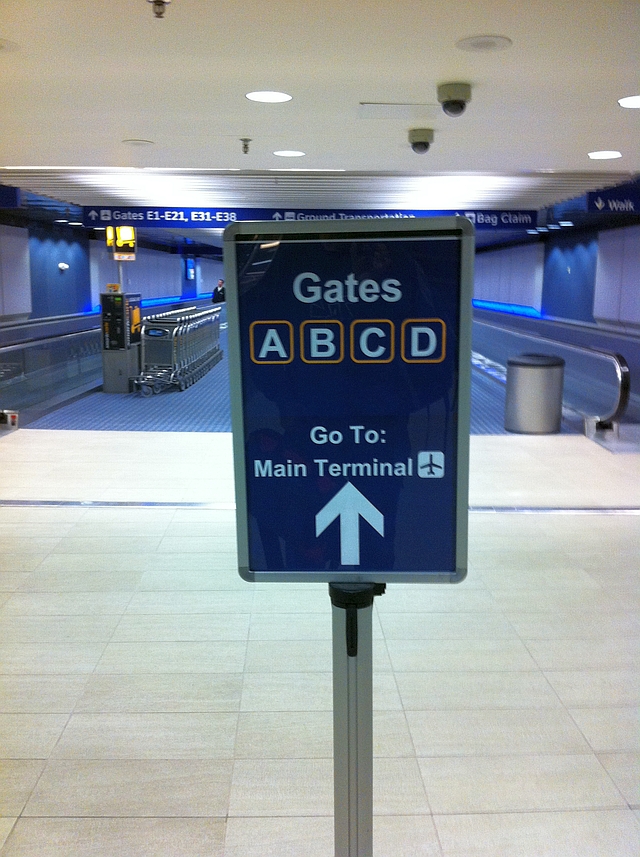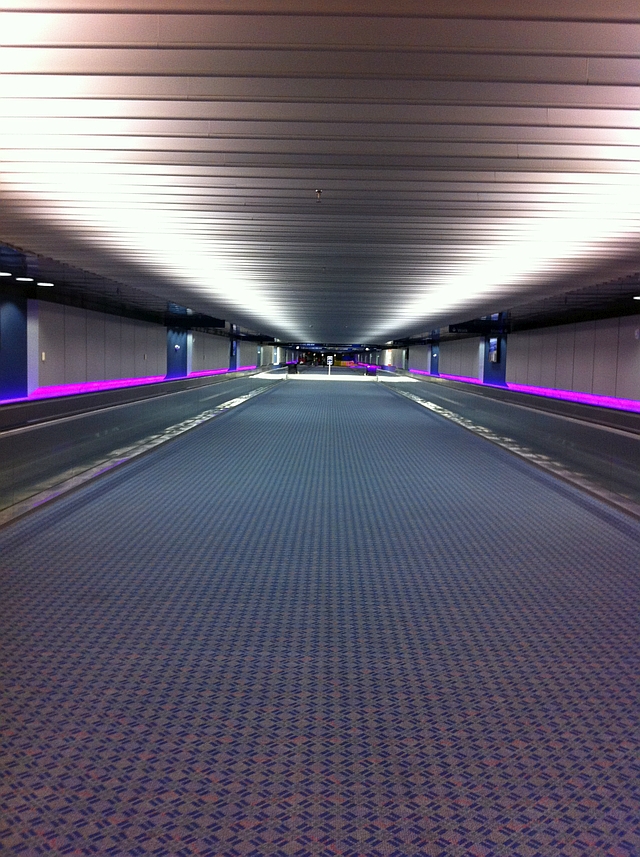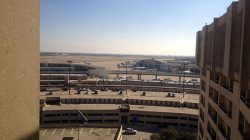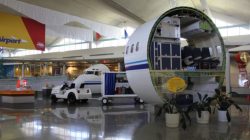DFW Airport has a well-deserved reputation as a busy airport. It carries more than 60 million passengers annually as the world’s 9th busiest airport by passenger volume. Anyone who calls the Metroplex home, or passes through the airport courtesy of AA’s sprawling hub covering four terminals, can surely attest that the airport can be a bustling, crowded place, especially if you visit during peak periods.
However, among all the hustle and bustle, there is one decidedly quiet, some would say moribund, terminal. That is Terminal E, better known as DFW’s “cats and dogs” terminal. In other words, the terminal you’ll use if you’re one of the 15 percent of passengers NOT flying American. Last fall, I flew Delta to Ft. Myers, Florida via Atlanta, primarily to evaluate DL’s Economy and Economy Comfort offerings. Thanks to my shuttle arriving very early, I had plenty of time to walk the terminal from end to end and prepare a write-up of the airport’s lonelier side.
Brief History of Terminal E
Terminal E wasn’t always as quiet as it is today. One of the airport’s four original terminals when DFW opened on January 13, 1974, Delta long called Terminal E (originally called Terminal 4E) home. Though Delta barely has a presence here today, the airline ran a mini-hub at DFW for 31 years; it controlled nearly 30% of DFW traffic at one point. In the mid-1980s, Delta’s DFW hub grew rapidly. The airline, in partnership with the airport, began constructing what is perhaps DFW’s most unique feature. That’s the 9-gate “satellite” terminal across the apron from the main Terminal E connected by an underground walkway; construction finished in 1988 at a cost of $32.5 million. This gave Delta control of 25+ of the expanded terminal’s 35 gates, with more than 350 departures a day, That even included international flights to Frankfurt at the hub’s peak in the early 90s.
In addition, DL famously marketed connections through the expanded DFW hub with the “Easy Street” ad campaign. The campaign was a not-so-subtle dig at AA’s hub operation, which by sprawled across all three other terminals. (Those included 2E, 2W, and 3E, now A, B, and C, respectively). Prior to the completion of Terminal D and the Skylink train system in 2005, connecting on AA via DFW was a real chore. It required a ride on the slow, rickety trAAin or the Terminal Link shuttle bus. Both required re-clearing security on the other side. Or you could take a really long walk through the horseshoe-shaped terminals. Poor saps running at full sprint through the terminals due to late arriving flights were an all-too familiar sight. DL’s Easy Street, though, meant simple connections within the same terminal. That provided big selling point at the time, as it allowed for short, seamless connections.
The good times wouldn’t last long, though. Even with the advantages of Easy Street, Delta never could out-muscle the big man on campus, American. Many analysts reported that Delta lost money on its hub even during the early 90s heyday. Significant cuts occurred by 1995, with departures dropping to approximately 230 per day; this eventually fell to the 180-ish range by 2000. The final death knell came after 9/11 and the ensuing recession, deep cuts in business travel, and rising oil prices. Although daily departures briefly increased to approximately 260 per day by 2003, almost all service by this point was on regional partners, with less than 60 filghts operated on mainline Delta aircraft.
Finally, in 2005, with its market share down to 16% and the airline in general in dire straits, Delta pulled the plug on the hub entirely, abandoning 24 gates while downsizing to just 22 flights a day to DL hubs Atlanta, Cincinnati, and Salt Lake City. DFW mothballed the satellite gates, and Terminal E became a virtual ghost town. The only other service out of the terminal were a handful of flights on SkyTeam partners Continental and Northwest, and (I think) a couple of other smaller airlines like ATA.
On a side note, the closure of the Delta hub involved DFW in another aviation controversy roiling North Texas at the time – Southwest’s attempt to overturn the Wright Amendment so that it could operate nonstop flights anywhere from Love Field. The airport board dangled a year of free rent and up to $22 million in incentives to any new airline. Speculation at the time was that DFW specifically courted Southwest to relocate to Terminal E. Ultimately, of course, that didn’t happen. Local officials and the airlines agreed to a Wright repeal compromise in 2006.
Terminal E in the Post-Delta Era
Luckily for poor old Terminal E, the airport found an alternate use for at least some of the gates pretty quickly. With the exception of Continental and Northwest, most other airlines operated out of Terminal B. But with American Eagle planning a major expansion push at DFW, it needed all of terminal’s gates and more. Thus, DFW moved the orphan airlines – AirTran, Frontier, Midwest, America West, and US Airways – to Terminal E in 2006. Traffic levels still paled in comparison to the days of the Delta hub. But at least the terminal didn’t feel completely dead.
The terminal actually began to experience significant passenger growth post-2010. This time, thank the rapid expansion of a new kid in town, ultra low-cost carrier Spirit Airlines. With Spirit only operating out of 5 gates in the southern end of the terminal, though, most of the action was relegated to that one end. To the airport’s credit, despite the drastic drop-off in traffic, it kept Terminal E in relatively decent shape, aside from the lack of vendors. DFW included it in the airport’s Terminal Renewal and Improvement Program (TRIP), which rebuilds Terminals A, B, C, and E in stages.
The terminal’s reconstruction also led to another exciting development, the reopening of the satellite terminal to allow airlines to rotate to those gates while their gates in the main terminal were rebuilt. DFW reopened the satellite in 2013, though it’s unclear just how long they will remain in use. Update: though currently closed as of early 2019, American plans to repurpose the satellite as a new regional jet concourse. Sometime this spring, American plans to reopen the satellite, expanding it from 9 gates to 15.
A Tour of Terminal E As it Looks Today
My flight departed from Gate E14, right in the middle of the terminal. For the purposes of this virtual tour, though, I’ll be starting at the northern end (E2-E10) and work my way south (E31-E38), before ending with the satellite terminal (E22-E30). NOTE: when originally written, Gates E18-E21 and E31-E38 had already been renovated. As of August, 2017, all gates in the main terminal fully reopened. Unfortunately, that meant the closing once again of the satellite terminal (though not for long).
Star Alliance occupies the far northern end of the terminal, with United and Air Canada. WestJet, Alaska, and JetBlue also occupy the north end, with Alaska temporarily relocated to the satellite during reconstruction. Concessions are pretty dire in this end – your choice of Burger King, Dunkin Donuts, or Starbucks. You may wonder why AC and WS operate out of Terminal E, instead of international Terminal D; this is because flights originate at customs pre-clearance airports in Canada.
Air Canada gate, E2
Seating area at Gate E2
One of DFW’s famous free internet/charging stations
Walkway with traditional DFW blue carpet approaching Gate E7
JetBlue gate area (E10)
You can see the general theme of this post already. Yes, Saturday morning isn’t a busy travel time, but there just aren’t very many people around at all. Granted, the airlines in this end have very little presence at DFW; only 26 flights a day operate out of 9 gates. One nice thing about the low traffic levels, though – the charging stations, unlike the ones scattered about the rest of the airport, are usually unoccupied. If I get to the airport early, I sometimes sneak over to Terminal E on the Skylink to grab a charge before taking off. If you have a long layover at DFW and don’t have access to a lounge, try that if you can’t find a charging station in your terminal.
As for the “free internet”, that is a relic of when DFW charged a fee for WiFi. You could plug in an ethernet cable at one of those stations and get free broadband. It’s a moot point today, since AT&T provides free WiFi throughout the airport.
The middle gates, E11-E21, are primarily the home of Frontier and Delta, though Spirit occasionally uses Gates E18 and E20. While its current gates are being rebuilt, Delta has been temporarily relocated to, ironically enough, the satellite terminal built specifically for DL before it was abandoned. Concessions aren’t much better in this section, with a couple of shops, a Sonny Bryan’s (you can do much, much better when it comes to Texas BBQ), a TGI Friday’s, a Blimpie’s, a Haagen Daas counter, and a Peet’s Coffee & Tea. This portion is equally lonely, with 20 flights a day on Delta and another 5 on Frontier.
Looking out over the airfield near Gate E12
Fish tank near the entrance to the satellite tunnel
Old tile flooring near Gate E16
Terrazzo artwork and construction just past Gate E21
Moving on to the southernmost portion of the terminal, and the only portion where the TRIP renovations had been completed during my visit, the quickly expanding Spirit, currently at 24 flights a day uses Gates E31-E34. US Airways, currently at 17 flights a day, uses Gates E35-E38. That makes this the busiest section of Terminal E by default, with 41 departures per day over 8 gates. As mentioned earlier, I haven’t heard what’s going to happen once the AA/US merger is complete, but I am assuming that any flights currently operated by US will move over to one of the other AA terminals.
The terminal refurbishment program has two primary goals in the passenger areas – replace the aging carpet, tile, and seating areas, but also modernize the displays and provide a more open, airy feel in the gate areas. With that, I think they’ve succeeded; you’ll notice all the extra light in the Spirit Airlines gate below. Following completion of TRIP in 2017, power ports also finally made an appearance in the seating areas.
Fresh tile at Gate E32
US Airways jet at Gate E36
Looking towards concession area still under construction by Gate E32
Rebuilt Spirit Airlines Gate E32, with fancy new monitors and better natural light – but still no plugs
The other benefit to TRIP is modernized, higher quality concessions, and this portion of Terminal E is no exception. A Genghis Grill and Pizzeria Uno (admittedly not my favorite Chicago pizza joint) were already open on the date of my visit. The locally popular, Dallas-based Blue Mesa Grill also had a restaurant under construction next to Wendy’s at E32. One of those free internet/free power stations is also located at E37. Update: a decent burger joint, Fort Worth celebrity chef Tim Love’s Love Shack, recently opened near Gate E11.
I’ve saved the most interesting piece for last, and that is the satellite terminal, housing gates E22-E30. The gates are accessed by an escalator and tunnel between gates E21 and E30. When the satellite was reopened, changeable, glowing lights were added at the bottom of the walls. Something you’d expect to find on a Virgin America flight, which is kind of ironic given that VX recently skipped town to Love Field. Delta and Alaska currently operate out of the satellite, with a few temporary concessions open (Dickey’s, Pizza Hut Express, Einstein Brothers, and the Fly Bar).
People say that the Dickey’s at E27 is the best BBQ on airport property, a claim I have not taste-tested myself; Dickey’s has been a Metroplex institution for decades, though I find the BBQ pretty average. Still, it’s better than your usual airport fast food. It will be interesting to see if these gates stay open once the terminal renovation is complete. My guess is no, so if you’re a hardcore avgeek and want to check them out, I suggest you plan to do so in the next 12-18 months.
The Easy Street tunnel to the satellite gates
North end of the satellite near Dickey’s – notice the old-style gate signage and low ceilings
South end of the satellite
Some very comfy looking lounge chairs with plugs near the entrance to the tunnel
Reassurance signage that yes, this is the way to the main terminal
The tunnel again, with its Star Trek lighting
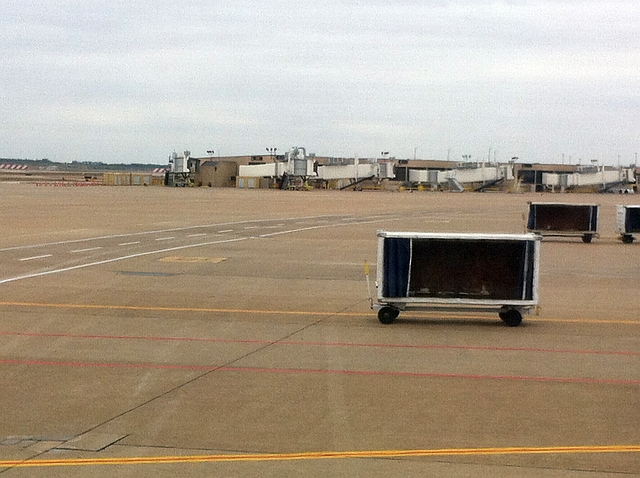
View of the satellite gates from my window seat on a DL MD-88
It will be interesting to see what the future holds for Terminal E. The emergence of Spirit has given the terminal some life, but still, it carries just 92 flights a day out of the 27 gates currently in use. Compared to Love Field, which handles 179 flights a day out of just 20 gates, the terminal is clearly underutilized, and its utilization is set to drop even further if, as expected, the New American moves the current US Airways flights to one of the other AA terminals. It’s also unclear what exactly DFW can do to fill up the terminal.
Spirit plans to continue using DFW as a focus city, and will undoubtedly increase departures some. But it’s hard to see them getting beyond 40-50 departures a day given its business model. United certainly isn’t going to try expanding at DFW with its IAH hub only 240 miles away, and Delta doesn’t seem likely to revive their hub either, especially since their focus right now seems to be picking up more gates at DAL.
Perhaps they’ll try again with Southwest in a few years, since DAL is now capped at 20 gates (though I have a sneaking suspicion that gate cap is going to be revisited sooner rather than later). Most likely, poor Terminal E will remain as it is today – a place to sneak away to on the Skylink for some peace and quiet, and the unoccupied power stations.


